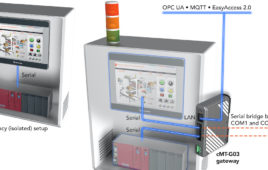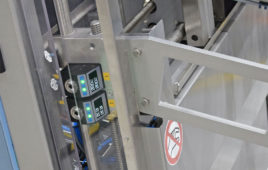With the industry’s current economic environment, oil and gas leaders are forging innovative paths with technology to better their businesses.
After a market downturn, businesses reduced capital expenditures and projects, and suppliers were pressed for better pricing. Though these measures were necessary, oil and gas executives recognize the need for new strategies to ensure long-term profitability.
This is where the Internet of Things (IoT) comes in. It can play an important role in driving these strategic goals, and oil and gas companies are embracing the technology.
It is expected that IoT monitoring of pipeline and storage tanks will have a compound annual growth rate of 21 percent year over year. In addition to the better management of production, transport, refining, processing and distribution, the real value of IoT is in the information generated.
Connected devices funnel a constant flow of data into dedicated analytic tools. Oil and gas companies can then use that information to gain valuable insights into their businesses and take concrete steps to help improve operations.Safety factors, time management and cost controls are key considerations for the industry.
IoT solutions are available to help address all of these needs.

Oil site. (Courtesy of AT&T)
Protect Your Employees
For example, a large integrated energy company needed to monitor employees working alone in the field. They wanted a solution for workers to be both active and reactive—one that monitored a lack of motion as well as gave them a panic button to press for help.
We created a wearable pendant with cellular and satellite radio connectivity. This IoT solution helps reduce the risk to field workers, especially those in remote locations, since the client is able to respond to safety issues more quickly.
But there’s potential to take this a step further.
Personal sensor networks could monitor and track workers’ vital statistics, such as heartbeat, pulse, and body temperature and activity level. This would give concerned parties instant awareness. These sensors could also let workers know if they are at risk, entering sensitive areas or even crossing into restricted safety zones.
Companies could design programs to respond immediately to incidents– or even as they are about to happen– based on predictive analytics. By connecting such a wearable sensor network to an intelligent, cloud-based storage and processing facility, users could build rules and policies to lower risks.
Maintain Control: Virtually Anytime, Anywhere
Managing tanks and totes is another area where we can intelligently apply IoT.
Take a company with cryogenic tanks for carbon dioxide storage. Old models used costly remote terminal units connected via expensive analog cellular or POTS lines. Reporting occurred once a day and went into a data warehouse. But deviations caused serious problems for resupply.
This enterprise now deploys cellular-based gateways, which communicate from tank level sensors in near real-time to a cloud analytics and billing platform. The result? Increased efficiency in resupply operations, more reliable level control and huge cost savings.Today, refining and processing plants monitor various points to maintain optimized throughput. The data lets operators make the necessary adjustments to correct deviations. Captured data also allows for periodic reports and comparisons to determine overall efficiency.

Oil tank. (Courtesy of AT&T)
Still on the Fench About IoT?
There are countless opportunities for IoT across integrated energy companies:
|
Upstream |
Midstream |
Downstream |
|
Asset Tracking |
Tank Farm Monitoring |
Perimeter Security Sensors |
|
Vehicle Monitoring |
Field Crew Monitoring |
Perimeter Video Camera |
|
Remote Video |
Remote Video |
Mobile Asset Tracking |
|
Machine Monitoring |
Pipeline Monitoring |
Vehicle Monitoring |
|
Site Monitoring |
Terminal Access control |
Production Sensors |
|
Well Head Monitoring |
Asset Tracking |
IoT Cloud Storage |
|
Security/Access Sensors |
Flow Meter Connectivity |
Lone Worker Wearables |
|
Lone Worker Tracking |
|
Contractor Tracking |
|
Tank Monitoring |
|
|
IoT has a central purpose: Help businesses manage their processes more efficiently. But it also makes it possible to collect and analyze data across the ecosystem for more cost-effective decision making and strategic planning. There are two layers of analytics businesses will want to be aware of.
First, they can analyze the connectivity service layer data to improve reliability. Building analytics, reporting and automation into network functions gives enterprises a distinct advantage. It minimizes the cost to run these solutions as well as the impact of potential outages. When the analytics engine senses a problem, pre-defined remediation routines can bring the connection back online.
The second layer of analytics is on the machine data itself. In this case, the analytics can go two ways: remote agents residing on the field gateway and heavy analytics within a premise or cloud-based platform.
Guard Yourself Against Cyber Attacks
With IoT strategies – and thousands of new connection points on networks – security becomes top of mind. Preparing for and defending against a cyberattack is more important than ever. Oil and gas companies are choosing to make incident response an investment and priority to help ensure that any damages caused by a major breach are kept to a minimum.
This kind of response means:
- Investing in prevention and detection technologies to defend against attacks
- Building a response team that includes all key internal stakeholders, from the C-suite to first responders
- Having a clear plan for the first 24 hours after breach detection
- Conducting regular tabletop exercises
- Establishing protocols on breach response with all service providers
And companies recognize the importance of protecting the hardware (the “things” connected via the internet) through measures with the device manufacturer and the Subscriber Identification Module (SIM). This provides a flexible and scalable level of security on the device.
Data transitions to and from the connected device through solutions like Virtual Private Network, cloud tunnels, network tunneling and custom private Access Point Names (APNs). Protecting it throughout its journey can minimize or even eliminate data leakage.
Research has shown that organizations more proactive with their cybersecurity initiatives exhibit higher levels of profits, growth and customer satisfaction. The ability to respond quickly and thoroughly to a cyberattack will determine whether the breach becomes a minor footnote or a major distraction.
Deliver More Business Value Faster
Energy companies are focusing on optimizing operations. They’re looking to IoT for help. It’s important they evaluate the financial model and total cost of ownership. Capital expense limits, and the technology restrictions of legacy radio systems, need to be carefully weighed against the ever-expanding, lower-cost operating expense models of carrier cellular networks.
After all, current global volatility and industry health have driven home the message that digital transformation is a strategic imperative not just to survive, but thrive in the future.
When strategically deployed, IoT serves as a key contributor to this digital transformation. It can meet both short- and long-term needs for optimization and efficiency. IoT technologies can help reduce headcount, drive down maintenance costs and improve safety in the short term. But it can also leave lasting effects. It can help improve overall operational efficiency, lower operating costs and improve the awareness of and decision making for oil and gas executives.
References
Berg Insight, M2M Applications in the Oil and Gas Industry, M2M Research Series 2015.
Deloitte University Press, “Connected barrels: Transforming oil and gas strategies with the Internet of Things,” Aug, 2015.
AT&T Cybersecurity Insights, Vol. 3, The CEO’s Guide to Cyberbreach Response, 2016.
Frost & Sullivan, Digital Transformation in the Oil & Gas Industry, July 2016
Filed Under: DIGITAL TRANSFORMATION (DX), M2M (machine to machine)




